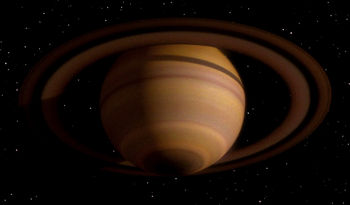Difference between revisions of "Saturn (Planet)"
From Trekipedia
m |
m |
||
| Line 1: | Line 1: | ||
| − | + | {{ImageBox|imgname=saturn-tng-101-102|caption=Saturn ([[Star Trek: The Next Generation|TNG]] [[Encounter at Farpoint (Episode)|101-102]])}} | |
| − | + | {{BoxOutline|width=30%|float=left}} | |
===Planetary Data=== | ===Planetary Data=== | ||
{| | {| | ||
|- | |- | ||
| − | |class="HeaderRow ButtonLeft"| Affiliation: | + | |class="HeaderRow ButtonLeft" style="width=30%;text-align:right;vertical-align:top;"| Affiliation: |
| [[United Federation of Planets]]<ref name="TOS37"/> | | [[United Federation of Planets]]<ref name="TOS37"/> | ||
|- | |- | ||
| − | |class="HeaderRow ButtonLeft"| Distance from Star: | + | |class="HeaderRow ButtonLeft" style="width=30%;text-align:right;vertical-align:top;"| Distance from Star: |
| 1,426,980,000km (9.5 [[astronomical unit|AU]]s)<ref name="STSC"/> | | 1,426,980,000km (9.5 [[astronomical unit|AU]]s)<ref name="STSC"/> | ||
|- | |- | ||
| − | |class="HeaderRow ButtonLeft"| Orbital Period: | + | |class="HeaderRow ButtonLeft" style="width=30%;text-align:right;vertical-align:top;"| Orbital Period: |
| 24,209.8 rotations (29.46 years)<ref name="STSC"/> | | 24,209.8 rotations (29.46 years)<ref name="STSC"/> | ||
|- | |- | ||
| − | |class="HeaderRow ButtonLeft"| Rotational Period: | + | |class="HeaderRow ButtonLeft" style="width=30%;text-align:right;vertical-align:top;"| Rotational Period: |
| 10 hours, 40 minutes<ref name="STSC"/> | | 10 hours, 40 minutes<ref name="STSC"/> | ||
|- | |- | ||
| − | |class="HeaderRow ButtonLeft"| Class: | + | |class="HeaderRow ButtonLeft" style="width=30%;text-align:right;vertical-align:top;"| Class: |
| [[Class J planet|J]]<ref name="STSC"/> | | [[Class J planet|J]]<ref name="STSC"/> | ||
|- | |- | ||
| − | |class="HeaderRow ButtonLeft"| Cloudtop Temperature: | + | |class="HeaderRow ButtonLeft" style="width=30%;text-align:right;vertical-align:top;"| Cloudtop Temperature: |
| -180°C<ref name="STSC"/> | | -180°C<ref name="STSC"/> | ||
|- | |- | ||
| − | |class="HeaderRow ButtonLeft"| Diameter: | + | |class="HeaderRow ButtonLeft" style="width=30%;text-align:right;vertical-align:top;"| Diameter: |
| 120,536km<ref name="STSC"/> | | 120,536km<ref name="STSC"/> | ||
|- | |- | ||
| − | |class="HeaderRow ButtonLeft"| Gravity: | + | |class="HeaderRow ButtonLeft" style="width=30%;text-align:right;vertical-align:top;"| Gravity: |
| 0.93g<ref name="STSC"/> | | 0.93g<ref name="STSC"/> | ||
|- | |- | ||
| − | |class="HeaderRow ButtonLeft"| Natural Satellites: | + | |class="HeaderRow ButtonLeft" style="width=30%;text-align:right;vertical-align:top;"| Natural Satellites: |
| Ring system;<ref name="TOS37"/> 18 moons,<ref name="STSC"/> including [[Titan]]<ref name="ST11"/> | | Ring system;<ref name="TOS37"/> 18 moons,<ref name="STSC"/> including [[Titan]]<ref name="ST11"/> | ||
|- | |- | ||
| − | |class="HeaderRow ButtonLeft"| Points of Interest: | + | |class="HeaderRow ButtonLeft" style="width=30%;text-align:right;vertical-align:top;"| Points of Interest: |
| [[Starfleet Academy Flight Range]]<ref name="TNG219"/> | | [[Starfleet Academy Flight Range]]<ref name="TNG219"/> | ||
|} | |} | ||
</div> | </div> | ||
Saturn, the sixth planet in the [[Sol system]],<ref name="TOS37"/> is home to the [[Starfleet Academy Flight Range]].<ref name="TNG219"/> | Saturn, the sixth planet in the [[Sol system]],<ref name="TOS37"/> is home to the [[Starfleet Academy Flight Range]].<ref name="TNG219"/> | ||
| − | + | ==Kelvin Timeline== | |
| − | == | + | On [[Stardate]] [[Kelvin Chronology#2258|2258.42]], the [[U.S.S. Enterprise NCC-1701 (Kelvin)|U.S.S. ''Enterprise'' NCC-1701]] evaded detection by the ''[[Narada]]'' during its attack on [[Earth#Kelvin Timeline|Earth]] by coming out of warp in the atmosphere of Saturn's moon [[Titan]].<ref name="ST11"/> |
| + | {{References}} | ||
<references> | <references> | ||
| − | <ref name="TOS37"> | + | <ref name="TOS37">{{RefTOS37}}</ref> |
<ref name="TNG219">[[The First Duty (Episode)|"The First Duty"]]. ''[[Star Trek: The Next Generation]],'' episode 219. Television. Paramount Pictures Corporation, 30 March 1992.</ref> | <ref name="TNG219">[[The First Duty (Episode)|"The First Duty"]]. ''[[Star Trek: The Next Generation]],'' episode 219. Television. Paramount Pictures Corporation, 30 March 1992.</ref> | ||
| − | <ref name="STSC"> | + | <ref name="STSC">{{RefSTSC}}</ref> |
| − | <ref name="ST11"> | + | <ref name="ST11">{{RefST11}}</ref> |
</references> | </references> | ||
| − | |||
[[Category:Library]] | [[Category:Library]] | ||
[[Category:Astrometrics]] | [[Category:Astrometrics]] | ||
| Line 57: | Line 57: | ||
[[Category:VOY]] | [[Category:VOY]] | ||
[[Category:ENT]] | [[Category:ENT]] | ||
| − | |||
[[Category:Film]] | [[Category:Film]] | ||
[[Category:Books]] | [[Category:Books]] | ||
| Line 67: | Line 66: | ||
[[Category:Decipher]] | [[Category:Decipher]] | ||
[[Category:Alternate Universes]] | [[Category:Alternate Universes]] | ||
| + | [[Category:Kelvin Timeline]] | ||
Revision as of 18:38, 29 August 2019
Planetary Data
| Affiliation: | United Federation of Planets[1] |
| Distance from Star: | 1,426,980,000km (9.5 AUs)[2] |
| Orbital Period: | 24,209.8 rotations (29.46 years)[2] |
| Rotational Period: | 10 hours, 40 minutes[2] |
| Class: | J[2] |
| Cloudtop Temperature: | -180°C[2] |
| Diameter: | 120,536km[2] |
| Gravity: | 0.93g[2] |
| Natural Satellites: | Ring system;[1] 18 moons,[2] including Titan[3] |
| Points of Interest: | Starfleet Academy Flight Range[4] |
Saturn, the sixth planet in the Sol system,[1] is home to the Starfleet Academy Flight Range.[4]
Kelvin Timeline
On Stardate 2258.42, the U.S.S. Enterprise NCC-1701 evaded detection by the Narada during its attack on Earth by coming out of warp in the atmosphere of Saturn's moon Titan.[3]
Notes and References
- ↑ 1.0 1.1 1.2 Roddenberry, Gene (Executive Producer). "The Changeling." Star Trek, Season 2, Episode 8. Directed by Marc Daniels. Written by John Meredyth Lucas. Desilu Productions, 29 September 1967.
- ↑ 2.0 2.1 2.2 2.3 2.4 2.5 2.6 2.7 Mandel, Geoffrey. Star Trek: Star Charts. Pocket Books, 2002.
- ↑ 3.0 3.1 Abrams, J.J. & Damon Lindelof (Producers). Star Trek. Directed by J.J. Abrams. Written by Roberto Orci & Alex Kurtzman. Paramount Pictures. 8 May 2009.
- ↑ 4.0 4.1 "The First Duty". Star Trek: The Next Generation, episode 219. Television. Paramount Pictures Corporation, 30 March 1992.
